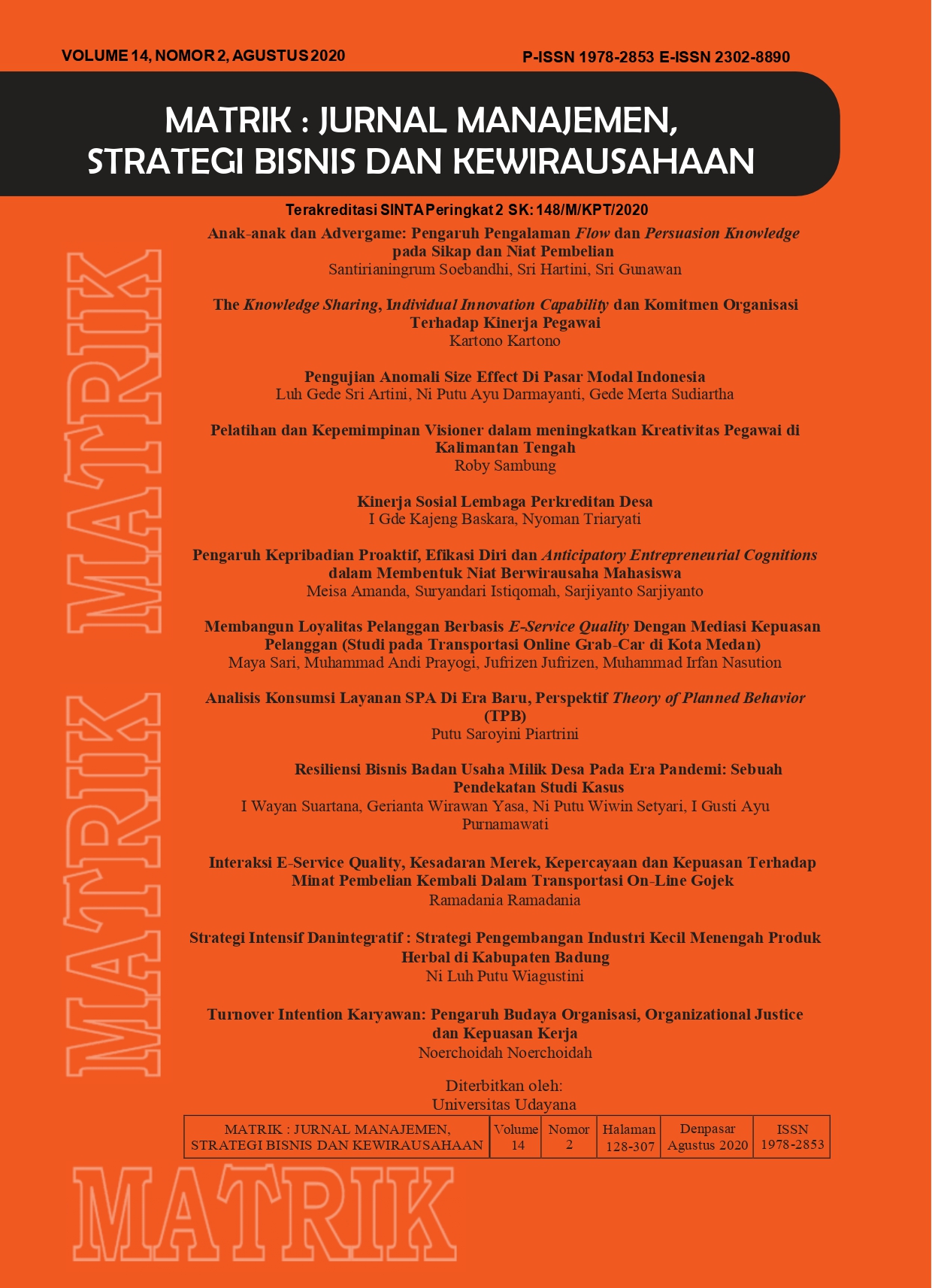Pengaruh Kepribadian Proaktif, Efikasi Diri dan Anticipatory Entrepreneurial Cognitions dalam Membentuk Niat Berwirausaha Mahasiswa
Abstract
This research aims to examine how a proactive personality and entrepreneurial self-efficacy of students may affect the entrepreneurial intentions in students is mediated by the creative self-efficacy, learning self-efficacy and anticipatory entrepreneurial cognitions. This research was conducted on students of Sebelas Maret University, taken using the technique of probability sampling that is stratified random sampling with the number of respondents in this study as much as 610 students. This research uses the structural equation modeling. The results of this research it can be concluded that: 1) proactive personality of Sebelas Maret University’s students associated positively with entrepreneurial self-efficacy that is mediated by creative self-efficacy and learning self-efficacy; 2) trait competitiveness of Sebelas Maret University’s students associated positively with entrepreneurial self-efficacy that is mediated by the creative self-efficacy and learning self-efficacy; 3) entrepreneurial self-efficacy of Sebelas Maret University’s students were associated positively with students entrepreneurial intentions is mediated by anticipatory entrepreneurial cognitions. This research has limitations in terms of subject and object of research, because the focus of the research only to students who are still active in the college’s activities and conducted in Sebelas Maret University’s environment. So in the next research is expected to complete the limitations in this research.
Downloads
References
Ajzen, I. (2002). Perceived behavioural control, self-efficacy, locus of control and the theory of planned behaviour. Journal of Applied Social Psychology, 32(4), 665–683.
Arikunto, S. (2010). Prosedur Penelitian Suatu Pendekatan Praktik. Rineka Cipta, Jakarta.
Badan Pusat Statistik Indonesia. Data Jumlah Penduduk Indonesia. https://databoks.katadata.co.id/datapublish/2018/01/12/berapa-jumlah-penduduk-indonesia. Diakses pada 25 April 2018.
Badan Pusat Statistik Indonesia. Data Pengangguran Terbuka. https://www.bps.go.id/statictable/2009/04/16/972/pengangguran-terbuka-menurut-pendidikan-tertinggi-yang-ditamatkan-1986---2019.html. Diakses pada 25 September 2019.
Badan Pusat Statistuk Indonesia. Data Pengangguran Terbuka Menurut Provinsi. https://www.bps.go.id/statictable/2014/09/15/981/tingkat-pengangguran-terbuka-tpt-menurut-provinsi-1986---2019.html. Diakses pada 25 September 2019.
Baron, R. A. & Byrne, D. (2004). Psikologi Sosial. Jakarta: Erlangga
Bandura, A. (1997). Self-efficacy (The Exercise Of Control). W. H. Freeman and Company, New York.
Bandura, A. (2007). Much ado over a faulty conception of perceived self-efficacy grounded in faulty experimentation. Journal of Social and Clinical Psychology, 26(6),
641–658.
Bateman, T. S., & Crant, J. M. (1993). The proactive component of organizational be- havior: A measure and correlates. Journal of Organizational Behavior, 14(2), 103–118.
Bjornskov, C., & Foss, N. (2013). How strategic entrepreneurship and the institutional context drive economic growth. Strategic Entrepreneurship Journal, 7, 50–69.
Brown, S. P., Cron, W. L., & Slocum, J. W., (1998). Effects of Trait Competitiveness and Perceived Intraorganizational Competition on Salesperson Goal Setting and Performance. Journal of Marketing, 62(4), 88–98.
Bygrave, W, D. (2003). The Portable MBA Entrepreneurship. Binarupa Aksara, Jakarta.
Carland, J.W., Hoy, F., Boulton, W.R. and Carland, J. A. C. (1984).. Differentiating Entrepreneurs From Small Business Owners: A Conceptualization. Academy of Management Review, 9(2), 354-359.
Chen, C., Greene, P. & Crick, A. (1998). Does Entrepreneurial Self-Efficacy Distinguish Entrepreneurs From Managers?. Journal of Business Venturing, 13(4), 610-316.
Crant, J.M. (1996). The Proactive Personality Scale as a Predictor of Entrepreneurial Intention. Journal of Small Bussines Management, 34, 42-49
Crant, J. M., & Bateman, T. S. (2000). Charismatic leadership viewed from above: The impact of proactive personality. Journal of Organizational Behavior, 21(1), 63–75.
DeNoble, A., Jung D., & Ehrlich, S. (1999). Entrepreneurial Self Efficacy: The Development Of a Measure And Its Relationship To Entrepreneurial Action. In Frontiers Of Entrepreneurship Research, Wellesey MA: Babson College.
Fuller, B., Liu, Y, Bajaba, S., Marler, E.L., & Pratt, J. (2018). Examining How The Personality, Self-efficacy, and Anticipatory Cognitions of Potential Entrepreneurs Shape Their Entrepreneurial Intentions. Personality and Individual Differences, 125, 120-125.
Ghozali, I. 2006. Structural Equation Modeling Metode Alternatif dengan Partial Least Square. Badan Penerbit Universitas Diponegoro, Semarang.
Ghozali, I. 2011. Structural Equation Modeling Metode Alternatif Dengan Partial Least Square (PLS). Edisi 3, Badan Penerbit Universitas Diponegoro. Semarang.
Hair, J. F., Black, W., Babin, B. J., & Anderson, R. E. (2010). Multivariate Data Analysis. United Stated of America: Pearson Prentise Hall.
Hisrich, R. D., Peters, M. P., & Shepherd, D. A. (2008). Kewirausahaan. Jakarta: Salemba Empat.
Hornaday, J. A. and Aboud, J. 1971. Characteristics of successful entrepreneurs. Personnel Psychology, 24, 141-153
Jogiyanto, H. (2004). Metodologi Penelitian Bisnis. Edisi 2004-2005, BPFE, Yogyakarta.
King, R. B., McInerney, D. M., & Watkins, D. A. (2012). How you think about your intelligence determines how you feel in school: The role of theories of intelligence on academic emotions. Learning and Individual Differences, 22, 814–819. https://doi.org/10.1016/j.lindif.2012.04.005
Kreitner, K. (2010). Organizational Behavior. New York: McGraw-Hill
Krishnan, B.C., Netemeyer, R.G and Boles, J.S. (2002) Self-Efficacy, Competitiveness, And Effort As Antecedents Of Salesperso n Performance Study in cellular phone company 115 southeastern United States. The Journal of Personal Selling and Sales Management. 22, 285-295.
Krueger, N. F. (1993). The Impact of Prior Entrepreneurial Exposure on Perceptions of New Venture Feasibility and Desirability. Entrepreneurship Theory and Practice, 18, 5–21.
Krueger & Brazeal, (1994). Entrepreneurial potential and potential entrepreneurs. Entrepreneurship Theory and Practice, 18, 91–104.
Krueger, N. F. (2000). The Cognitive Structure of Opportunity Emergence. Entrepreneurship Theory and Practice, 25, 5–23.
Lado, A. A., & Vozikis G. S. (1996). Transfer of Technology to Promote Entrepreneurship in Developing Countries: An Integration and Proposed Framework. Entrepreneurship Theory and Practice, 21, 55–72.
Lambing, P. & Charles R. K. (2000). Entrepreneurship Second Edition. Prentice Hall, New Jersey.
Lee, L., Wong, P. K., Foo, M. D., & Leung, A. (2011). Entrepreneurial intentions: The influence of organizational and individual factors. Journal of Business Venturing, 26, 124–136.
Nickerson, R. (1999). The Teaching of Thinking. New Jersey: Lawrence Erlbaum
Major, D. A., Turner, J. E., & Fletcher, T. D. (2006). Linking proactive personality and the Big Five to motivation to learn and development activity. Journal of applied psychology, 91, 927.
Porter, M. E. (1990). Competitive Strategy. Technique For Analysing Industries and Competitors. The Free Press, New York.
Michael, H. & Andreas, M. K. (2004). A Beginner's Guide to Partial Least Square Analysis. Lawrence Erlbaum Association, Inc.
Potosky, D., and Ramakrishna, H. V. (2002). The Moderating Role of Updating Climate Perceptions in The Relationship Between Goal Orientation, Self-Efficacy, and Job Performance. Human Performance, 15, 275–297.
Purwanto, N. (1990). Psikologi Pendidikan. Remaja Rosdakarya, Bandung.
Riani, A. L. (2005). Dasar-Dasar Kewirausahaan. UPT Penerbitan dan Percetakan UNS (UNS Press), Surakarta.
Robbins S.P., & Judge. (2007). Perilaku Organisasi, Salemba Empat, Jakarta.
Schunk, D. H. (1989). Self-efficacy and cognitive achievement implications for students with learning problems. Journal of Learning Disabilities, 22, 14–22.
Seibert, S. E., Crant, J. M., & Kraimer, M. L. (1999). Proactive Personality and Career Success. Journal of Applied Psychology, 84, 416–427.
Sekaran, U. and Bougie, R. (2013). Research Methods for Business. Wiley, United Kingdom
Shane, S., & Venkatraman, S. (2000). The Promise of Entrepreneurship as a Field of Research. Academy of Management Review, 25, 217.
Shapero, A. and Sokol, L. (1982): Social dimensions of entreprenurship. Kent, C.A., Sexton, D.L. and Vesper, K.H. (eds.): Encyclopaedia of entrepreneurship, Prentice Hall, Englewood Cliffs (NJ).
Steward, W. H. (2001). Risk Peopensity Differences Between Entrepreneur and Managers: A Meta-Analytic Review. Journal of Applied Psycology, 86, 145-153.
Stewart, Jr. W. H., Carland J. C., Carland J.W., Watson W. E. & Sweo R. (2003). Entrepreneurial Dispositions and Goal Orientations: A Compative Exploration of United States and Russian Entrepreneurs. Journal of Small Business Management, 41(1), 27-46.
Sugiyono. (2014). Metode Penelitian Pendidikan Pendekatan Kuantitatif, Kualitatif, dan R&D. Alfabeta, Bandung.
Suryana. (2003). Kewirausahaan: Pedoman Praktis, Kiat dan Proses Menuju Sukses. Salemba Empat, Jakarta.
Tenenhaus, M., Vinzi V. E., Chatelin, Y. & Lauro, C. 2005. PLS Path Modeling. Computational Statistics & Data Analysis, 48(1), 159-364.
Tierney, P. A. & Farmer, S. M. (2002). Creative Self-Efficacy: Its Potential Antecedents and Relationship to Creative Performance. Academy of Management Journal, 45(6), 1137–1148.
Tambunan, T. H. 2001. Perekonomian Indonesia. Penerbit Ghalia, Jakarta.
Van Praag, C. M. & Versloot P. H. (2007). What Is the Value of Entrepreneurship? A Review of Recent Research. Small Business Economics, 29(4), 351–382.
Walgito, B. 2004. Pengantar Psikologi Umum. Penerbit Andi, Jakarta.
Warr, P., & Bunce, D. (1995). Trainee characteristics and the outcomes of open learning. Personnel Psychology, 48(2), 347–375.
Wang, G. & Netemeyer R.G. (2002). The Effects of Job Autonomy Customer Demandingness, and Trait Competitiveness on Salesperson Learning, Self-Efficacy, and Performance. Journal ofthe Academy of Marketing Science, 30, 217 228.
Wetzels, M., Odekerken-Schroder, G., & Van Oppen, C. (2009). Using PLS path modeling for assessing hierarchical construct models: guidelines and empirical illustration. MIS Q, 33 (1), 177-195.
Wijanto, S. H. 2008. Structural Equation Modeling. Graha Ilmu, Yogyakarta.
Wood, R. E & Bandura, A. (1989). Social cognitive theory of organizational management. Academy of Management Review, 14, 361-384.
Zhao, H., Seibert, S. E., & Hills, G. E. (2005). The Mediating Role of Self-Efficacy in The Development of Entrepreneurial Intentions. Journal of Applied Psychology, 90(6), 1265–1272.
Zimmerer, T W & Scarborough N M. (2008). Kewirausahaan dan Manajemen Usaha Kecil. Jakarta:Selemba Empat
 This work is licensed under a Creative Commons Attribution-ShareAlike 4.0 International License.
This work is licensed under a Creative Commons Attribution-ShareAlike 4.0 International License.

















